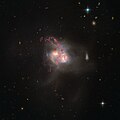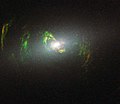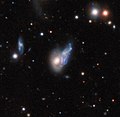An extended emission-line region (EELR) is a giant interstellar cloud ionized by the radiation of an active galactic nucleus (AGN) inside a galaxy or photons produced by the shocks associated with the radio jets. [1] An EELR can appear as a resolved cloud in relative nearby galaxies and as narrow emission lines in more distant galaxies.
Contents

EELRs were first discovered in radio galaxies. Usually the clouds emitting the narrow emission lines are restricted to a few kiloparsecs within the AGN, but some galaxies have narrow emission lines that extend a few kiloparsec to over 100 kiloparsecs. These clouds where therefore called extended emission-line regions (EELRs) and usually have a large doubly ionized oxygen [O III]/Hβ ratio, as well as a strong ionized helium He II/Hβ ratio (oxygen line at 5007 Å, helium line at 4686 Å). In some cases these EELRs show highly ionized species, such as calcium [Ca V] and iron [Fe VII] [Fe X]. [2] Another common highly ionized species is the emission of neon [Ne V] (main line at 3426 Å). [3] [4] This high level of ionization shows that the EELRs must be ionized by a mechanism related to the nucleus of the galaxy. HII regions do not show this high level of ionization. [2] The first [O III] images of EELRs were around galaxies, such as 3C 79, [5] 4C 37.43, [6] NGC 3516 [7] or NGC 4151. [8]
In 2009 a large cloud was discovered that had similar spectral features as EELRs, but had no ionizing AGN nearby. It was concluded that the nearby galaxy IC 2497 hosted an AGN in the past. Today this AGN faded into inactivity. The hard ionizing radiation did however need time to travel the thousands of lightyears towards a cloud, which would later become Hanny's Voorwerp. This makes Hanny's Voorwerp the first EELR associated with a fading AGN. Previously EELRs were commonly first discovered via spectroscopy and required high-resolution imaging to further resolve the EELRs. Hanny's Voorwerp was however discovered in broad band imaging from the Sloan Digital Sky Survey. [3] This prompted a search for more EELRs in broad-band imaging surveys by galaxy zoo volunteers, who also discovered Hanny's Voorwerp. EELRs are called "Voorwerpjes" by the galaxy zoo members. [4] EELRs that are ionized by the AGN of a companion galaxy were also discovered. This type of ionization is called cross-ionization. [9]

In broad-band images the [O III] emission lines usually lie at the g-band. The true color of an EELR would be dominated by the [O III] emission, which is a cyan color. In astronomical imaging slightly false-color images that transform g, r and i bands into RGB-images are more common. Sometimes the i-band is replaced with a z-band image. The EELRs appear as blue (g-band) objects in these survey images. Sometimes the H-alpha line is redshifted enough to lie at the i-band, which can make the EELR appear as a blue-violet object in these survey images. [4] Sometimes the [O III] is redshifted enough that this line overlaps with the r-band or i-band, which makes them green or red in survey images of the Hyper Suprime-Cam. [11] At around 0.1 < z < 0.38 the 5006.843 Å [O III] line is redshifted to the r-band and at 0.38 < z < 0.68 it is redshifted to the i-band. [note 1] A team of researchers detected a resolved EELR at a high redshift of 4.54 in a galaxy protocluster with JWST. [13]
Another related type of cloud is a extended narrow-line region (ENLR). The EELRs usually have dynamically chaotic structures and high velocities and are probably the result of mergers. ENLRs on the other hand follow the disk structure of the galaxy and have a low velocity. [11]
Recently a connection between EELRs and Tidal Disruption Events (TDE), as well as quasi-periodic X-ray eruption (QPE) was found. This connection is explained with TDEs and QPEs favouring a gas-rich post-merger environment. It is possible that repeated TDEs could power EELRs. On the other hand a fading AGN could result in an increase of the rate of TDEs. [14] [15]












































